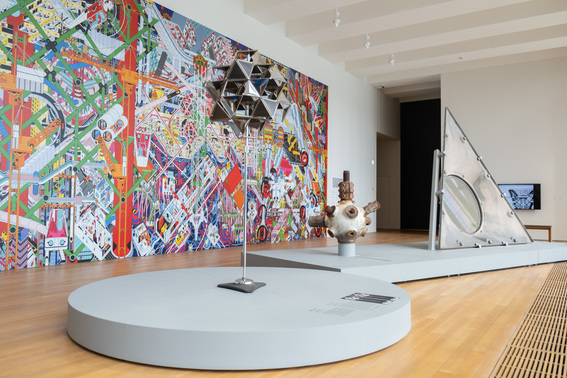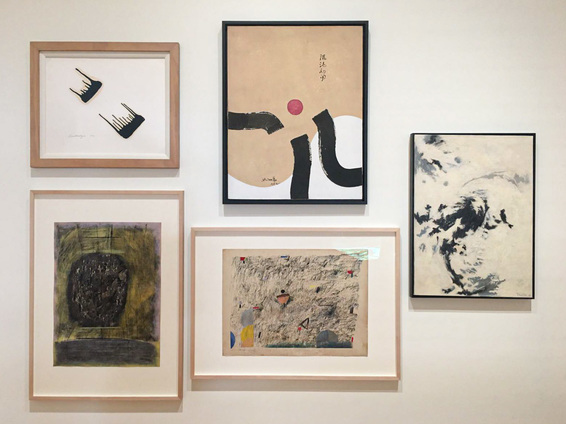
R
E
V N
E
X
T
It turns out “late 2021” were the magic words. After years of delays and anticipation, visitors were finally welcomed into Hong Kong’s M+ museum on November 12. Demonstrating the breadth of the museum’s ambit, the six opening exhibitions span 20th- and 21st-century art, architecture, and design, with a total of 1,539 works—roughly 20 percent of the collection—by 777 artists and designers from over 35 countries. While the interdisciplinary “Hong Kong: Here and Beyond” is focused on the museum’s locale, “M+ Sigg Collection: From Revolution to Globalisation” takes audiences through the history of contemporary Chinese art from 1970 to 2012; “Things, Spaces, Interactions” spotlights design and architecture; “Individuals, Networks, Expressions” homes in on artistic and cultural exchanges since the 1950s with a focus on Asia; “The Dream of the Museum” examines conceptualism and the continuous artistic challenges posed to definitions of art; and “Antony Gormley: Asian Field” consists of a single, densely packed installation of miniature clay figurines. Downstairs in the Found Space are a trio of oversized installations and sculptures by Danh Vo, Haegue Yang, and Chen Zhen.
An all-in-one visit to the visually saturated presentations, each reflecting a different exhibition-making approach, is not recommended for the faint of heart or thin of sole—or, indeed, anyone. Museum fatigue is real no matter how new the museum. These shows warrant multiple trips and ample time. Here are some highlight stops from the dizzying array of exhibitions that comprise M+’s inaugural season.
Main Hall Gallery: “Hong Kong: Here and Beyond”
Out of all the programs on view, this Hong Kong-focused showcase most clearly eschews chronology, and instead is constructed around four thematic chapters: “Here,” on the cultural factors that shape Hong Kong; “Identities,” on the city’s internal understanding and external presentation of itself; “Places,” on the built environment; and “Beyond,” on new perspectives. This curatorial approach was perhaps buoyed by the assumption that local audiences will already be somewhat familiar with the city’s visual materials and is aimed at deepening that knowledge. Seen in “Beyond,” for instance, is the two-channel video-essay Where Do We Look Now? (2021). Produced by M+, the display anachronically pairs clips from 23 movies presenting visions of Hong Kong, from Ten Years (2015) to Mr Vampire (1985). Stepping inside the black cube where the work is projected, the aggregated, fictive Hong Kongs become a hyper-surreal space that prompts reflections on how we view the city. Another memorable work is Freeman Lau’s pair of posters The Changing Era (1997), with the slogans “Finally returned” and “Should return.” Produced at the pivot point between the city’s colonial and postcolonial epochs, the images allude to a dislocated sense of place and identity.
Sigg Galleries: “M+ Sigg Collection: From Revolution to Globalisation”
The museum’s largest show draws from the world’s most comprehensive collection of contemporary Chinese art, and, in contrast to “Hong Kong: Here and Beyond,” aligns closely to a chronological timeline, with each of the galleries focused around the characteristics of a certain period. While this helps somewhat in the navigation of a complex history, the sheer volume of works on view is staggering. On one side of the first room are propaganda paintings of proletariat heroes in action, such as Wu Yunhua’s From the Tiger’s Mouth (1972). On the opposite wall are smaller canvases by artists who were propelling a growing underground movement against state dictates—these works depict decidedly more humble subjects like Fish (1978, Yuan Jia) and Bamboo Shoot (1979, Zhu Jinshi). From there, the show moves into the key avant-garde movements and exhibitions of the 1980s, the emergence of Chinese art on the global stage as well as the subcurrents of the 1990s, and artistic responses to urbanization and globalization in the new millennium.
At the press preview, Sigg senior curator Pi Li described the show as a “textbook” account of contemporary Chinese art, echoing his past comments about the goal of creating an authoritative narrative of contemporary Chinese art history that also takes into account possibilities of rupture and artistic drives to toe the line of what constitutes art. This comment raises the question of whether the materials in this show would be considered a canon and draws attention to the benefits and pitfalls of constructing an Asian art canon more broadly. To what extent would this linear approach be a reiteration of Western epistemologies? What other ways are there to understand cultural fields?
East Galleries: “Things, Spaces, Interactions”
Another curatorial method undergirds the exhibition of 500-plus design and architecture objects, “Things, Spaces, Interactions,” which has both thematic focuses and a loose chronology that spans the postwar and postcolonial period, when Asian nations were constructing new national identities and imagining new ways of life, to the postmodern era and the present day. An example of how the axes of theme and time intersect within the sections of the show can be seen in the “Future Cities” chapter, on 1960s–70s utopian projects. In one of the rooms is a triangular panel from the 127-meter-tall tower that stood at the 1970 Japan World Exposition in Osaka. The rare piece of Metabolist architecture was designed by Kikutake Kiyonori, who was interested in replicable housing units as a means to rebuild postwar Japan. In a corner of the same gallery is a video of Kacey Wong’s Paddling Home (2009–10) project, in which the artist sailed out from the West Kowloon waterfront in his floating, idyllic microhome that measures 1.2 meters by 1.2 meters, replete with a rooftop golf pad. Though Wong’s work was made nearly 40 years later, its inclusion added a satirical perspective on the ambitions of utopia-building. In another example of how disparate elements are combined for storytelling, the “Questions for Design” section, focused on the present, brings together a photo by Bas Princen, showing land reclamation in Singapore, with an array of circuit boards and Revital Cohen and Tuur Van Balen’s H/AiCuTaAu (2014), a mashup of the precious metals used in electronic devices. Together, the objects point to issues of resource extraction in the physical and technological infrastructure of cities today.
South Galleries: “Individuals, Networks, Expressions”
Perhaps another way of complicating linear, exclusionary art histories is focusing on artistic exchanges and the points of contact between individuals on a network. This methodology shaped “Individuals, Networks, Expressions.” The first of the six parts highlights how global cultures have influenced abstraction, with canvases by artists such as Hsiao Chin, who was born in Shanghai in 1935 and subsequently became familiar with abstract-expressionist tenets as he traveled across the United States and Europe. After settling in Milan, he co-founded the Punto movement in 1961 with an international group of collaborators, including Italian painter Antonio Calderara and Japanese sculptor Azuma Kenjiro, combining Asian spiritual ideals of mindfulness with abstract image-making. From there, however, the show’s organizing principle becomes increasingly implicit, with sections on the Gutai Art Association, sculptures, diasporas, China, and global connections, where visitors can mail a letter to whoever they want as part of Lee Mingwei’s The Letter Writing Project (1998).
Installation view of YOUNG-HAE CHANG HEAVY INDUSTRIES’ CRUCIFIED TVS—NOT A PRAYER IN HEAVEN (TRADITIONAL CHINESE/CANTONESE/ENGLISH VERSION), 2021, five-channel video installation: 17 min, at M+, Hong Kong, 2021.
Focus Gallery: Young-Hae Chang Heavy Industries
Walking across the second floor, visitors will hear the sounds emanating from Young-Hae Chang Heavy Industries’ newly commissioned CRUCIFIED TVS—NOT A PRAYER IN HEAVEN (TRADITIONAL CHINESE/CANTONESE/ENGLISH VERSION) (2021). The crucifix-shaped video installation, suspended in the airy, chapel-like Focus Gallery, flashes texts like “Is a world on fire like a life in hell?” A choir sings in an ecstatic refrain: “Oh yeah.” If you were looking for an ironic embrace of the world’s dismal state, this is it.
Chloe Chu is the managing editor of ArtAsiaPacific.
To read more of ArtAsiaPacific’s articles, visit our Digital Library.













